-
 Site of Franklin Hall
(The Mound)
Site of Franklin Hall
(The Mound) Franklin Hall, an early University dormitory designed by Capt. William Nichols, was erected on this site in 1835. Was one of the buildings destroyed by the Union raid on April 4, 1865. After Civil War the remains of structure were shaped into present mound. By early 20th century this mound had become traditional site for honorary tappings by The University.
Marker donated by Phi Mu Sorority in commemoration of its 50th anniversary at the University of Alabama.
-
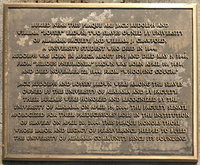 Slave cemetery plaque
Slave cemetery plaque Buried near this plaque are Jack Rudolph and William “Boysey” Brown, two slaves owned by University of Alabama faculty, and William J. Crawford, a University student who died in 1844.
Rudolph was born in Africa about 1791 and died May 5, 1846, from “Bilious Pneumonia.” Brown was born April 10, 1838, and died November 22, 1844, from “Whooping Cough.”
Jack Rudolph and Boysey Brown were among the slaves owned by the University of Alabama and by faculty. Their burials were honored and recognized by the University of Alabama on April 15, 2004. The Faculty Senate apologized for their predecessors’ role in the institution of slavery on April 20, 2004. This plaque honors those whose labor and legacy of perseverance helped to build the University of Alabama Community since its founding.
-
 The President's Mansion
The President's Mansion In 1838 The University of Alabama Board of Trustees appropriated funds for a more suitable residence for the University's new president Basil Manly. The mansion on this site was built between 1839 and 1841 from plans provided by Michael Barry who served as architect and building superintendent for the project. Although Manly, the mansions first occupant was a very popular president, the legislature regarded the structure as unnecessarily lavish. According to tradition, Louisa Frances Garland, wife of President Landon C. Garland, valiantly saved the stately residence from destruction when Union Troops under the command of Major General John T. Croxten destroyed the campus on April 4, 1865. The mansion, which has undergone a number of restorations assumed its predominantly white appearance in 1908.
-
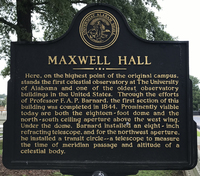 Maxwell Hall
Maxwell Hall [front]
Here, on the highest point of the original campus, stands the first celestial observatory at The University of Alabama and one of the oldest observatory buildings in the United States. Through the efforts of Professor F. A. P. Barnard, the first section of this building was completed in 1844. Prominently visible today are both the eighteen-foot dome and the north-south ceiling aperture above the west wing. Under the dome, Barnard installed an eight-inch refracting telescope, and for the northwest aperture, he installed a transit circle--a telescope to measure the time of meridian passage and altitude of a celestial body.
[reverse]
In 1858, a large classroom was added as an east wing, and today it is the oldest classroom on campus. Although ransacked by Union troops on April 4, 1865, the Observatory was one of only four structures to survive the destruction of the campus. Early in the twentieth century, the building was used for student housing. Rep. Carl Elliot lived here as an undergraduate. Later, offices for various University agencies were located here, and in 1986 the structure was named in honor of Fred R. Maxwell, Jr. for his long and dedicated service to the University. In 1993, the building was refurbished for the use of New College's External Degree and Computer-Based Honors Programs.
-
 Marr's Spring
Marr's Spring Part of Marr’s Field, on farmland owned by William Marr, this spring was a major factor in the selection of this site for the University of Alabama campus in 1827. From its opening in 1831 well into the 20th century, the institution relied upon Marr’s Spring as its principal water source. Water flowing from hillside crevices was collected in these brick cisterns and hauled in buckets to the rooms of students and throughout the campus. A dam for a swimming pond and bathhouse was constructed, supported by the spring and cisterns. By the mid-1880s, as the cisterns began to deteriorate, the University considered repairs until deciding, as the 1889 trustees’ minutes recorded, “it has always been considered doubtful whether the plunging and swimming in the very cold water so directly from the spring is conducive to health.” A 1955 survey found that Marr’s Spring yielded 100 gallons of good, clear odorless water per minute. The cisterns were renovated in 2010 in an effort to restore the original beauty of this University of Alabama historical landmark.
-
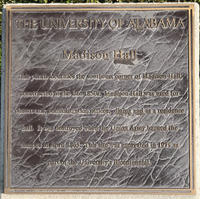 Madison Hall
Madison Hall The University of Alabama
Madison Hall
This plinth identified the southeast corner of Madison Hall, constructed in the late 1850s. Madison Hall was used for classrooms, administration offices, dining and as a residence hall. It was destroyed when the Union Army burned the campus in April 1865. This site was excavated in 1975 as part of the University's Bicentennial.
-
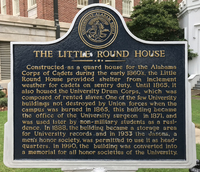 The Little Round House
The Little Round House The Little Round House
Constructed as a guard house for the Alabama Corps of Cadets during the early 1860's, the Little Round House provided shelter from inclement weather for cadets on sentry duty. Until 1865, it also housed the University Drum Corps, which was composed of rented slaves. One of the few University buildings not destroyed by Union forces when the campus was burned in 1865, this building became the office of the University surgeon in 1871, and was used later by non-military students as a residence. In 1888, the building became a storage area for University records and in 1933 the Jasons, a men's honor society, was permitted to use it as headquarters. In 1990, the building was converted into a memorial for all honor societies of the University.
-
 Gorgas-Manly Historical District
Gorgas-Manly Historical District [front]
Gorgas-Manly Historical District
includes
The Gorgas House (1829)
First structure built on the original campus
The Round House (1860)
Used by cadets on guard duty, and another of the four buildings to survive the fires set by Federal troops in 1865
Woods Hall (1868)
First building constructed after the Civil War and serving for the next sixteen years as the University
Manly (1886)*, Clark (1886), and Garland (1888) Halls
Built as the state began to recover from the Reconstruction Era
[*On November 13, 2020, the University of Alabama Board of Trustees voted unanimously to rename this building to Presidents Hall, to remove its association with Basil Manly, Sr., a slave-owning Baptist minister and president of the University of Alabama (1837-1855) who defended slavery and promoted a religious justification for white supremacy.]
Toumey and Barnard Halls (1838)*
which completed the nineteenth-century University of Alabama campus
[*these buildings were completed in 1889]
[reverse]
Twelve Acres of the campus of the University of Alabama
including eight buildings designated in
The National Register Of Historic Places
as
The Gorgas-Manly Historic District
-
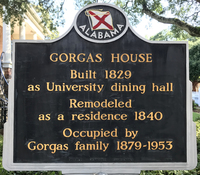 Gorgas House
Gorgas House [front]
Built 1829 as University dining hall
Remodeled as a residence in 1840
Occupied by Gorgas family 1879-1953
[reverse]
Preserved as memorial to:
General Josiah Gorgas (1818-1883)
Chief of Ordnance Confederacy 1861-1865
President of University 1878-1879
Mrs. Amelia Gayle Gorgas (1826-1913)
University Librarian 1879-1906
General William Crawford Gorgas (1854-1920)
Surgeon General of U.S. Army
Sanitary Engineer whose work in eliminating yellow fever assured Construction of Panama Canal
 Site of Franklin Hall
(The Mound) Franklin Hall, an early University dormitory designed by Capt. William Nichols, was erected on this site in 1835. Was one of the buildings destroyed by the Union raid on April 4, 1865. After Civil War the remains of structure were shaped into present mound. By early 20th century this mound had become traditional site for honorary tappings by The University. Marker donated by Phi Mu Sorority in commemoration of its 50th anniversary at the University of Alabama.
Site of Franklin Hall
(The Mound) Franklin Hall, an early University dormitory designed by Capt. William Nichols, was erected on this site in 1835. Was one of the buildings destroyed by the Union raid on April 4, 1865. After Civil War the remains of structure were shaped into present mound. By early 20th century this mound had become traditional site for honorary tappings by The University. Marker donated by Phi Mu Sorority in commemoration of its 50th anniversary at the University of Alabama. Slave cemetery plaque Buried near this plaque are Jack Rudolph and William “Boysey” Brown, two slaves owned by University of Alabama faculty, and William J. Crawford, a University student who died in 1844. Rudolph was born in Africa about 1791 and died May 5, 1846, from “Bilious Pneumonia.” Brown was born April 10, 1838, and died November 22, 1844, from “Whooping Cough.” Jack Rudolph and Boysey Brown were among the slaves owned by the University of Alabama and by faculty. Their burials were honored and recognized by the University of Alabama on April 15, 2004. The Faculty Senate apologized for their predecessors’ role in the institution of slavery on April 20, 2004. This plaque honors those whose labor and legacy of perseverance helped to build the University of Alabama Community since its founding.
Slave cemetery plaque Buried near this plaque are Jack Rudolph and William “Boysey” Brown, two slaves owned by University of Alabama faculty, and William J. Crawford, a University student who died in 1844. Rudolph was born in Africa about 1791 and died May 5, 1846, from “Bilious Pneumonia.” Brown was born April 10, 1838, and died November 22, 1844, from “Whooping Cough.” Jack Rudolph and Boysey Brown were among the slaves owned by the University of Alabama and by faculty. Their burials were honored and recognized by the University of Alabama on April 15, 2004. The Faculty Senate apologized for their predecessors’ role in the institution of slavery on April 20, 2004. This plaque honors those whose labor and legacy of perseverance helped to build the University of Alabama Community since its founding. The President's Mansion In 1838 The University of Alabama Board of Trustees appropriated funds for a more suitable residence for the University's new president Basil Manly. The mansion on this site was built between 1839 and 1841 from plans provided by Michael Barry who served as architect and building superintendent for the project. Although Manly, the mansions first occupant was a very popular president, the legislature regarded the structure as unnecessarily lavish. According to tradition, Louisa Frances Garland, wife of President Landon C. Garland, valiantly saved the stately residence from destruction when Union Troops under the command of Major General John T. Croxten destroyed the campus on April 4, 1865. The mansion, which has undergone a number of restorations assumed its predominantly white appearance in 1908.
The President's Mansion In 1838 The University of Alabama Board of Trustees appropriated funds for a more suitable residence for the University's new president Basil Manly. The mansion on this site was built between 1839 and 1841 from plans provided by Michael Barry who served as architect and building superintendent for the project. Although Manly, the mansions first occupant was a very popular president, the legislature regarded the structure as unnecessarily lavish. According to tradition, Louisa Frances Garland, wife of President Landon C. Garland, valiantly saved the stately residence from destruction when Union Troops under the command of Major General John T. Croxten destroyed the campus on April 4, 1865. The mansion, which has undergone a number of restorations assumed its predominantly white appearance in 1908. Maxwell Hall [front] Here, on the highest point of the original campus, stands the first celestial observatory at The University of Alabama and one of the oldest observatory buildings in the United States. Through the efforts of Professor F. A. P. Barnard, the first section of this building was completed in 1844. Prominently visible today are both the eighteen-foot dome and the north-south ceiling aperture above the west wing. Under the dome, Barnard installed an eight-inch refracting telescope, and for the northwest aperture, he installed a transit circle--a telescope to measure the time of meridian passage and altitude of a celestial body. [reverse] In 1858, a large classroom was added as an east wing, and today it is the oldest classroom on campus. Although ransacked by Union troops on April 4, 1865, the Observatory was one of only four structures to survive the destruction of the campus. Early in the twentieth century, the building was used for student housing. Rep. Carl Elliot lived here as an undergraduate. Later, offices for various University agencies were located here, and in 1986 the structure was named in honor of Fred R. Maxwell, Jr. for his long and dedicated service to the University. In 1993, the building was refurbished for the use of New College's External Degree and Computer-Based Honors Programs.
Maxwell Hall [front] Here, on the highest point of the original campus, stands the first celestial observatory at The University of Alabama and one of the oldest observatory buildings in the United States. Through the efforts of Professor F. A. P. Barnard, the first section of this building was completed in 1844. Prominently visible today are both the eighteen-foot dome and the north-south ceiling aperture above the west wing. Under the dome, Barnard installed an eight-inch refracting telescope, and for the northwest aperture, he installed a transit circle--a telescope to measure the time of meridian passage and altitude of a celestial body. [reverse] In 1858, a large classroom was added as an east wing, and today it is the oldest classroom on campus. Although ransacked by Union troops on April 4, 1865, the Observatory was one of only four structures to survive the destruction of the campus. Early in the twentieth century, the building was used for student housing. Rep. Carl Elliot lived here as an undergraduate. Later, offices for various University agencies were located here, and in 1986 the structure was named in honor of Fred R. Maxwell, Jr. for his long and dedicated service to the University. In 1993, the building was refurbished for the use of New College's External Degree and Computer-Based Honors Programs. Marr's Spring Part of Marr’s Field, on farmland owned by William Marr, this spring was a major factor in the selection of this site for the University of Alabama campus in 1827. From its opening in 1831 well into the 20th century, the institution relied upon Marr’s Spring as its principal water source. Water flowing from hillside crevices was collected in these brick cisterns and hauled in buckets to the rooms of students and throughout the campus. A dam for a swimming pond and bathhouse was constructed, supported by the spring and cisterns. By the mid-1880s, as the cisterns began to deteriorate, the University considered repairs until deciding, as the 1889 trustees’ minutes recorded, “it has always been considered doubtful whether the plunging and swimming in the very cold water so directly from the spring is conducive to health.” A 1955 survey found that Marr’s Spring yielded 100 gallons of good, clear odorless water per minute. The cisterns were renovated in 2010 in an effort to restore the original beauty of this University of Alabama historical landmark.
Marr's Spring Part of Marr’s Field, on farmland owned by William Marr, this spring was a major factor in the selection of this site for the University of Alabama campus in 1827. From its opening in 1831 well into the 20th century, the institution relied upon Marr’s Spring as its principal water source. Water flowing from hillside crevices was collected in these brick cisterns and hauled in buckets to the rooms of students and throughout the campus. A dam for a swimming pond and bathhouse was constructed, supported by the spring and cisterns. By the mid-1880s, as the cisterns began to deteriorate, the University considered repairs until deciding, as the 1889 trustees’ minutes recorded, “it has always been considered doubtful whether the plunging and swimming in the very cold water so directly from the spring is conducive to health.” A 1955 survey found that Marr’s Spring yielded 100 gallons of good, clear odorless water per minute. The cisterns were renovated in 2010 in an effort to restore the original beauty of this University of Alabama historical landmark. Madison Hall The University of Alabama Madison Hall This plinth identified the southeast corner of Madison Hall, constructed in the late 1850s. Madison Hall was used for classrooms, administration offices, dining and as a residence hall. It was destroyed when the Union Army burned the campus in April 1865. This site was excavated in 1975 as part of the University's Bicentennial.
Madison Hall The University of Alabama Madison Hall This plinth identified the southeast corner of Madison Hall, constructed in the late 1850s. Madison Hall was used for classrooms, administration offices, dining and as a residence hall. It was destroyed when the Union Army burned the campus in April 1865. This site was excavated in 1975 as part of the University's Bicentennial. The Little Round House The Little Round House Constructed as a guard house for the Alabama Corps of Cadets during the early 1860's, the Little Round House provided shelter from inclement weather for cadets on sentry duty. Until 1865, it also housed the University Drum Corps, which was composed of rented slaves. One of the few University buildings not destroyed by Union forces when the campus was burned in 1865, this building became the office of the University surgeon in 1871, and was used later by non-military students as a residence. In 1888, the building became a storage area for University records and in 1933 the Jasons, a men's honor society, was permitted to use it as headquarters. In 1990, the building was converted into a memorial for all honor societies of the University.
The Little Round House The Little Round House Constructed as a guard house for the Alabama Corps of Cadets during the early 1860's, the Little Round House provided shelter from inclement weather for cadets on sentry duty. Until 1865, it also housed the University Drum Corps, which was composed of rented slaves. One of the few University buildings not destroyed by Union forces when the campus was burned in 1865, this building became the office of the University surgeon in 1871, and was used later by non-military students as a residence. In 1888, the building became a storage area for University records and in 1933 the Jasons, a men's honor society, was permitted to use it as headquarters. In 1990, the building was converted into a memorial for all honor societies of the University. Gorgas-Manly Historical District [front] Gorgas-Manly Historical District includes The Gorgas House (1829) First structure built on the original campus The Round House (1860) Used by cadets on guard duty, and another of the four buildings to survive the fires set by Federal troops in 1865 Woods Hall (1868) First building constructed after the Civil War and serving for the next sixteen years as the University Manly (1886)*, Clark (1886), and Garland (1888) Halls Built as the state began to recover from the Reconstruction Era [*On November 13, 2020, the University of Alabama Board of Trustees voted unanimously to rename this building to Presidents Hall, to remove its association with Basil Manly, Sr., a slave-owning Baptist minister and president of the University of Alabama (1837-1855) who defended slavery and promoted a religious justification for white supremacy.] Toumey and Barnard Halls (1838)* which completed the nineteenth-century University of Alabama campus [*these buildings were completed in 1889] [reverse] Twelve Acres of the campus of the University of Alabama including eight buildings designated in The National Register Of Historic Places as The Gorgas-Manly Historic District
Gorgas-Manly Historical District [front] Gorgas-Manly Historical District includes The Gorgas House (1829) First structure built on the original campus The Round House (1860) Used by cadets on guard duty, and another of the four buildings to survive the fires set by Federal troops in 1865 Woods Hall (1868) First building constructed after the Civil War and serving for the next sixteen years as the University Manly (1886)*, Clark (1886), and Garland (1888) Halls Built as the state began to recover from the Reconstruction Era [*On November 13, 2020, the University of Alabama Board of Trustees voted unanimously to rename this building to Presidents Hall, to remove its association with Basil Manly, Sr., a slave-owning Baptist minister and president of the University of Alabama (1837-1855) who defended slavery and promoted a religious justification for white supremacy.] Toumey and Barnard Halls (1838)* which completed the nineteenth-century University of Alabama campus [*these buildings were completed in 1889] [reverse] Twelve Acres of the campus of the University of Alabama including eight buildings designated in The National Register Of Historic Places as The Gorgas-Manly Historic District Gorgas House [front] Built 1829 as University dining hall Remodeled as a residence in 1840 Occupied by Gorgas family 1879-1953 [reverse] Preserved as memorial to: General Josiah Gorgas (1818-1883) Chief of Ordnance Confederacy 1861-1865 President of University 1878-1879 Mrs. Amelia Gayle Gorgas (1826-1913) University Librarian 1879-1906 General William Crawford Gorgas (1854-1920) Surgeon General of U.S. Army Sanitary Engineer whose work in eliminating yellow fever assured Construction of Panama Canal
Gorgas House [front] Built 1829 as University dining hall Remodeled as a residence in 1840 Occupied by Gorgas family 1879-1953 [reverse] Preserved as memorial to: General Josiah Gorgas (1818-1883) Chief of Ordnance Confederacy 1861-1865 President of University 1878-1879 Mrs. Amelia Gayle Gorgas (1826-1913) University Librarian 1879-1906 General William Crawford Gorgas (1854-1920) Surgeon General of U.S. Army Sanitary Engineer whose work in eliminating yellow fever assured Construction of Panama Canal